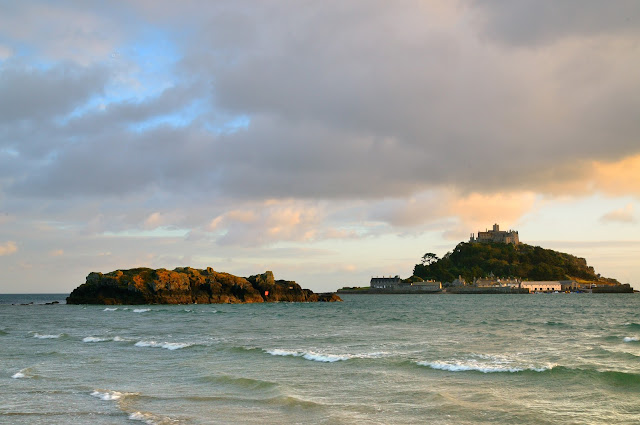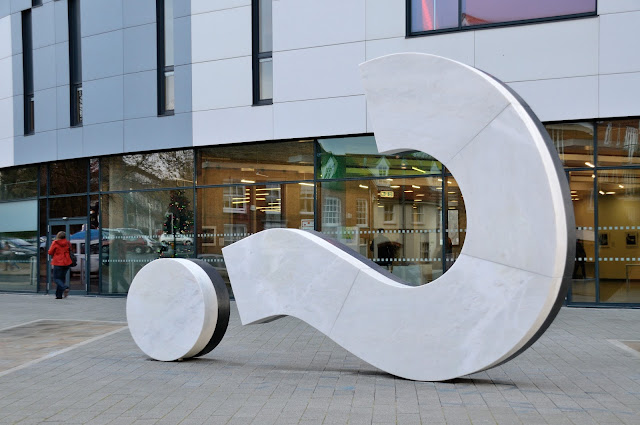We love Cornwall - what's not to like? So had decided to spend a week in Marazion, With stunning views toward the Lizard Peninsula and Land's End and its location opposite the fairy-tale castle perched on St Michael’s Mount. The town claims to be the oldest town in Britain and was called Ictis by the Romans which goes someway to indicate that the area was a trading post for tin in ancient times.
Our accomodation for the week was a lovely cottage overlooking Mount`s Bay, small but perfectly formed. All we wanted was the good weather!
St Michaels mount as the tide receded.
St Michael's Mount The island is a civil parish and is linked to the town of Marazion by a man-made causeway of granite setts, passable between mid-tide and low water. The population of this parish in 2011 was 35. It is managed by the National Trust, and the castle and chapel have been the home of the St Aubyn family since approximately 1650. The earliest buildings, on the summit, date to the 12th century.
It may have been the site of a monastery in the 8th – early 11th centuries and passed through many (mainly religious) hands in its life.
Little is known about the village before the beginning of the 18th century, save that there were a few fishermen's cottages and monastic cottages. After improvements to the harbour in 1727, St Michael's Mount became a flourishing seaport.
By 1811 there were fifty-three houses and four streets. The pier was extended in 1821 and the population peaked in the same year, when the island had 221 people. There were three schools, a Wesleyan chapel, and three public houses, mostly used by visiting sailors. The village went into decline following major improvements to nearby Penzance harbour and the extension of the railway to Penzance in 1852, and many of the houses and buildings were demolished. A short underground, funicular narrow gauge railway was built in Victorian times. It was used to bring luggage up to the house. It occasionally operates, but only for demonstration reasons and is not open to the general public, although a small stretch is visible at the harbour. It is Britain's last functionally operational 4 ft 6 in (1,372 mm) railway.
Now it is one of our great tourist attractions and also draws photographers from everywhere, trying to capture its magic.
Mousehole is a picturesque fishing village on the south coast of Cornwall between Penzance and Land’s End. It was sacked by the Spaniards in July 1595 when the entire village, apart from one house, was burnt to the ground. That house still stands today. A hundred years ago Mousehole was a bustling port, crowded with local fishing boats, landing pilchards. Each year, early in November, timber beams are laid across the narrow harbour entrance, to protect the village from the worst of the winter gales. Even so waves can still be seen breaking over the harbour wall at high tide.
Although we spent a day here, we did not wander the town much, but the beach and seafront were very picturesque.
Mousehole today has retained much of its old world charm. Its narrow streets are filled with small shops, galleries and restaurants. Local cottages built from finely grained Lamorna granite, huddle together around the inner edge of the harbour. The area is protected from the force of the sea by two sturdy breakwaters.
Seen outside a shop in Mousehole. I believe it's a Morgan
Surfboards ready for the waves.
Shapes on the beach.
St Ives is a seemingly subtropical oasis where the beaches are golden, the vegetation is lush and the light piercingly bright.
It’s no wonder then that the town has been attracting artists for decades who come to capture the area’s undeniable natural beauty. It started with J M W Turner and the marine artist Henry Moore who first came to St Ives in the mid-1800s and since then the town has become a magnet for some of the world’s greatest painters, sculptors and ceramists.
It’s the light. That’s what always strikes visitors who come to St Ives. Jutting out from the coastline, the town, which is surrounded by beaches, is bathed in a soft, romantic glow that makes everything look like Instagram-perfection: no filter necessary.
Porthmeor Beach
Waves breaking over the rocks on a beach near St Ives.
St Ives, a small Cornish town on the southwest coast of England, perhaps seems an unlikely site for a major art gallery. However, its artistic connections date back to Victorian times when numerous artists came to St Ives to paint, attracted by its special quality of light. Artists associated with the town include Barbara Hepworth, Naum Gabo, Alfred Wallis and Mark Rothko.
Tate had formed a close link with St Ives when it took over the management of the Barbara Hepworth Museum and Sculpture Garden in 1980. By the middle of the decade it was decided a gallery should be built there to show works by artists who had lived or worked in St Ives, loaned from the collection.
In 1988, a building was chosen on the site of a former gasworks overlooking Porthmeor Beach and the Atlantic Ocean. The architects Eldred Evans and David Shalev were selected for designs that echoed the shapes of the former gasworks, including the rotunda that forms the heart of the gallery.
Building work began in 1991, funded by donations from the local community, the Henry Moore Foundation and the European Regional Development Fund. The Tate Gallery, St Ives opened in June 1993 and in just six months welcomed over 120,000 visitors – 50,000 more than the original target for the entire year. Since then, the gallery has been an outstanding success with an average of 240,000 visitors per year.
As a result of the large number of visitors at the gallery, it was decided to refurbish and extend Tate St Ives. The making of the new Tate St Ives completed in summer 2017. The original architects, Evans and Shalev designed the changes to the existing building. Jamie Fobert Architects were commissioned to create the new extension which doubled the size of the exhibition space, increased facilities and added new art handling facilities.
Porthmeor Beach again.

















































